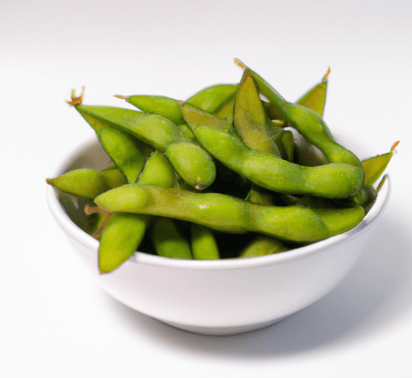Edamame: Important Facts, Health Benefits, and Recipes


Explore the health benefits, culinary uses, and history of edamame in our ultimate guide, and learn how to incorporate this nutritious, versatile ingredient into your meals.
What is Edamame?
Edamame is a type of immature soybean, harvested before it hardens and turns into the familiar beige color. These green soybeans are native to East Asia and have a sweet, mild, and slightly nutty flavor. Edamame is commonly served as a snack or appetizer, but it can also be incorporated into a variety of dishes, from salads to stir-fries.
Is Edamame Healthy?
Yes, edamame is healthy! Edamame is packed with nutrients, making it a healthy addition to any diet. It's an excellent source of protein, fiber, vitamins, and minerals, and has a low calorie count. Furthermore, it contains antioxidants and phytonutrients that contribute to overall health and well-being.
8 Health Benefits of Edamame
1. Rich in protein: Edamame is an excellent source of plant-based protein, making it a great option for vegetarians and vegans.
2. Supports heart health: The isoflavones in edamame have been linked to reduced cholesterol levels and a lower risk of heart disease.
3. Aids in weight management: The high fiber content in edamame keeps you feeling full, reducing the tendency to overeat.
4. Boosts immune system: Edamame is rich in vitamins and minerals that support a healthy immune system.
5. Improves bone health: The calcium and magnesium in edamame contribute to strong bones and teeth.
6. Supports digestion: The fiber in edamame promotes regular bowel movements and a healthy gut.
7. Enhances skin health: The antioxidants in edamame help protect the skin from damage caused by free radicals.
8. May reduce the risk of certain cancers: Some studies suggest that the isoflavones in edamame may lower the risk of breast and prostate cancer.
History and Background of Edamame
Edamame has been cultivated in China and Japan for thousands of years, where it was initially used as a medicinal plant. Over time, it became a popular food source and eventually spread to other parts of the world. Today, edamame is enjoyed globally for its taste, versatility, and health benefits.
What Is The Best Way To Store Edamame?
To preserve the freshness and quality of edamame, store it in an airtight container in the refrigerator and eat within a few days. If you have frozen edamame, keep it in the freezer until you're ready to use it.
Types of Edamame
While there aren't many distinct varieties of edamame, it can be found in various forms, including fresh, frozen, and dried. Additionally, edamame can be purchased shelled or in the pod, depending on your preference. If you order edamame in an Asian restaurant, it typically comes in the pod.
What Is The Best Substitute for Edamame If I Don't Have Any?
If you don't have edamame, you can substitute it with other green legumes, such as peas or fava beans. These alternatives share a similar texture and nutritional profile.
Cuisines That Use Edamame
Edamame is commonly used in Japanese, Chinese, Korean, and Thai cuisines.
Edamame vs. Soybeans
Edamame is the immature form of soybeans, harvested before they harden and change color. While both edamame and mature soybeans share similar nutritional profiles, edamame has a sweeter, milder flavor and a more tender texture.
Nutritional Benefits of Edamame
As stated above, edamame is an excellent source of plant-based protein, fiber, vitamins, and minerals. It's low in calories and contains antioxidants and phytonutrients that contribute to overall health.
Creative Ways to Incorporate Edamame into Meals
- Toss edamame into salads for added protein and crunch
- Blend edamame into a creamy hummus or dip
- Stir-fry edamame with other vegetables and your choice of protein.
- Add edamame to soups or stews for extra nutrients
- Mix edamame into pasta dishes or grain bowls for a satisfying meal.
People do not typically eat the pods so in all of these cases you would want to use shelled edamame.
Does Edamame Contain Estrogen?
Edamame, like other soy-based foods, contains compounds called phytoestrogens, specifically isoflavones, which are plant-based compounds that mimic the action of estrogen in the body, but they are much weaker than the estrogen produced by the human body.
Phytoestrogens in edamame and other soy foods can have both estrogenic (estrogen-like) and anti-estrogenic effects, depending on various factors, such as hormone levels and overall diet. For most people, consuming edamame and other soy foods in moderation is considered safe and can be part of a healthy diet. If you have concerns about how soy might affect your health, it's a good idea to consult with a healthcare provider.



:max_bytes(150000):strip_icc()/__opt__aboutcom__coeus__resources__content_migration__serious_eats__seriouseats.com__recipes__images__2012__01__20120115-guacamole-variations-34-7aa785087c9a4e3fa290dd3c4169121b.jpg)
:max_bytes(150000):strip_icc()/__opt__aboutcom__coeus__resources__content_migration__serious_eats__seriouseats.com__recipes__images__2012__04__20120410-201232-toasted-nori-edamame-31378589a96a4859b8c82443baa53c6c.jpg)